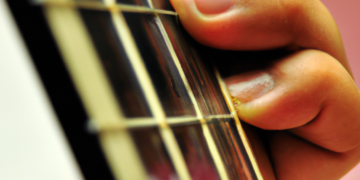Table of Contents
Introduction
Over the years, emo music has evolved from its humble beginnings in the 1980s to become a prominent and influential genre in contemporary music. Defined by its emotional lyrics and expressive melodies, emo has captivated audiences and left a lasting impact on the music scene. In this article, we will explore the origins of emo music, its rise in popularity, the various subgenres it has spawned, its influence on contemporary music, the misconceptions and stereotypes surrounding it, and what the future holds for this beloved genre.
Origins of Emo Music
The roots of emo music can be traced back to the punk and hardcore scenes of the 1980s. Bands such as Rites of Spring, Embrace, and Minor Threat were pioneers in blending the raw energy of punk with introspective and emotionally charged lyrics. Emo, short for “emotional hardcore,” emerged as a subgenre that focused on vulnerability and personal expression.
One of the defining features of early emo music was its focus on DIY (do-it-yourself) ethics, with bands often self-releasing their music and booking their own shows in small venues and basements. This grassroots approach allowed emo to develop a devoted and intimate community of listeners who resonated with the raw emotions conveyed in the music.
Emo’s Rise in Popularity
In the 1990s, emo music began to gain wider recognition and popularity. Bands like Sunny Day Real Estate and Jimmy Eat World brought emo into the mainstream with their melodic and introspective sound. The success of these bands paved the way for emo to reach a larger audience and gain a dedicated following.
It was during this time that emo started to evolve beyond its punk roots and incorporate elements from other genres like indie rock and pop punk. The incorporation of more melodic and accessible elements helped emo reach a wider audience while still maintaining its emotional core.
The Subgenres of Emo
As emo gained popularity, it gave rise to a variety of subgenres that expanded the boundaries of the genre. Some notable subgenres include:
- Post-hardcore: This subgenre combines the intensity and aggression of hardcore punk with the emotional depth of emo. Bands like Fugazi and Thursday pushed the boundaries of emo by incorporating more complex song structures and experimental sounds.
- Emo-pop: This subgenre blends emo with pop sensibilities, incorporating catchy hooks and upbeat melodies. Bands like Fall Out Boy and Panic! at the Disco found commercial success by merging emo’s emotional lyrics with infectious pop hooks.
- Math-rock: This subgenre explores complex rhythms and intricate guitar work, adding a technical and progressive element to emo. Bands like American Football and Cap’n Jazz introduced intricate guitar tapping and unconventional time signatures, pushing the boundaries of what emo could sound like.
These subgenres allowed emo to evolve and appeal to a wider range of listeners, while still maintaining the emotional authenticity that defines the genre.
The Influence of Emo on Contemporary Music
Emo’s influence can be felt across a wide range of contemporary music genres. Many artists today credit emo as a major influence on their sound and lyrical content. The confessional and introspective nature of emo has permeated genres such as pop, punk, and alternative rock.
Bands like Paramore and Twenty One Pilots draw heavily from emo’s emotional lyricism, infusing it with their own unique style and creating a blend of genres that resonates with a broad audience. Even artists outside of the alternative realm, like Taylor Swift and Billie Eilish, incorporate elements of emo in their music, embracing vulnerability and raw emotion as part of their artistic expression.
The DIY ethos that emo embodies has also been embraced by artists in various genres, with many independent musicians adopting the DIY approach to releasing music and connecting with fans directly.
Misconceptions and Stereotypes Surrounding Emo
Despite its enduring popularity and influence, emo music has often been subject to misconceptions and stereotypes. One common misconception is that emo music is solely about sadness and depression. While emo does delve into themes of melancholy, it also explores a wide range of emotions, from anger and frustration to self-reflection and hope. Emo music serves as a cathartic outlet for both the artists and listeners, providing a space to navigate and express complex emotions.
Another stereotype associated with emo is its fashion and aesthetics. Dark clothing, dyed hair, and heavy eyeliner are often associated with the emo subculture. However, it’s important to remember that emo is ultimately about the music and the emotions it conveys, rather than external appearances or fashion choices. Emo is a diverse and inclusive community that welcomes people from all walks of life, regardless of their outward appearance.
The Future of Emo Music
As we look to the future, it’s clear that emo music will continue to evolve and thrive. Artists will continue to push the boundaries of the genre, incorporating new sounds and influences while staying true to the emotional core that defines emo. The digital age has opened up new avenues for independent artists to release their music and connect with their audience, ensuring that emo will remain a vital and vibrant genre in contemporary music.
In conclusion, emo music has come a long way since its origins in the 1980s. From its grassroots beginnings to its rise in popularity, emo has left an indelible mark on the music scene. Its emotional depth and introspective lyrics continue to resonate with listeners across generations. As emo continues to evolve and push boundaries, its influence can be felt in a wide range of genres and its community will continue to thrive. Emo music is here to stay, providing a space for expression and connection for years to come.
“Emo music serves as a platform for raw emotions, allowing listeners to connect with their own experiences in a meaningful way.”

